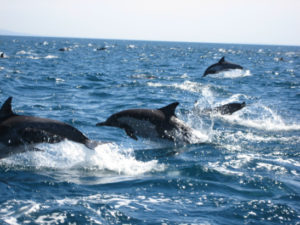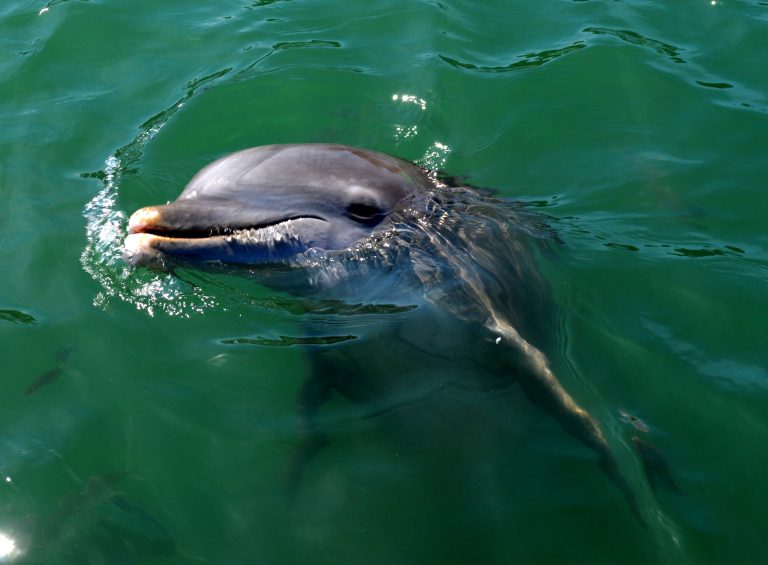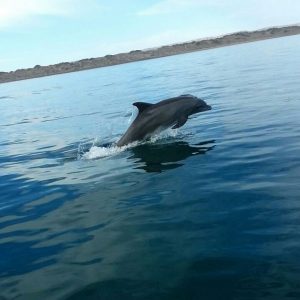
The Non-Human Persons of Baja: Our Souls in the Sea
by Todos Santos Eco Adventures
This article was first published in Janice Kinne’s Journal del Pacifico.
When the Supreme Court of the United States ruled in 2010 that “corporations are people”, it was a low day for homo sapiens throughout the world, many of whom felt their “personhood” assaulted, and who resented the notion that their “person” status should be shared with entities lacking a corporeal body ruled by intelligence and passion.
So when in August of this year the government of India became the first in the world to declare all cetaceans – including dolphins – non-human persons, those same homo sapiens breathed a sigh of relief that the standard for personhood had this time been raised, not lowered, and that once again personhood was a mantle to be worn proudly. But what about the dolphins? Did they consider personhood a serious downgrade in their global standing? Douglas Adams, author of the Hitchhiker’s Guide to the Galaxy, offers some insight: “It is an important and popular fact that things are not always what they seem. For instance, on the planet Earth, man had always assumed that he was more intelligent than dolphins because he had achieved so much – the wheel, New York, wars and so on – whilst all the dolphins had ever done was muck about in  the waves having a good time. But conversely, the dolphins had always believed that they were far more intelligent than man – for precisely the same reason.”
the waves having a good time. But conversely, the dolphins had always believed that they were far more intelligent than man – for precisely the same reason.”
Now of course when the US and Indian authorities declared corporations and dolphins people, they didn’t mean to suggest that either should embrace the institution of marriage, seek political office, or engage in other acts characteristic of homo sapiens with personhood status. What they meant is that both have implicit rights under the laws of the land and should be treated accordingly. For dolphins, this was an acknowledgement not only of their remarkable intelligence, but their human-like self-awareness. In 2001 the National Academy of Sciences published a study from Columbia and Emory Universities that proved dolphins recognize themselves when looking at their reflection. Of all the other animal species on the planet, only humans and our great ape cousins have demonstrated such mirror-awareness, and the researchers concluded that this stemmed from the dolphin’s large brain and advanced cognitive ability. In fact, just prior to the Indian government’s announcement about dolphins, researchers from the University of Chicago published research demonstrating that dolphins can remember the signature whistles – the dolphin equivalent of names – of absent friends for more than 20 years. The study’s author concluded that dolphins are “operating cognitively at a level that is very consistent with human social memory.”
 Other studies have demonstrated that dolphins use tools and understand abstract concepts, and it has been long recognized that dolphins form intimate, multi-generational family bonds that last for a lifetime. In short, they’re a lot like us, and the Indian government has honored that similarity by declaring that dolphins essentially have the same rights to life, liberty and the pursuit of happiness as homo sapiens; it banned captive dolphin shows and declared it is morally unacceptable to keep dolphins in captivity. Costa Rica, Chile and Croatia have also banned dolphin displays, while countries such as England and Brazil have regulated dolphin displays so heavily that they have become too expensive to operate. In other words, these nations have fixed it such that corporate persons cannot hold captive non-human persons for the pleasure of human persons. It’s a concept any dolphin brain can grasp!
Other studies have demonstrated that dolphins use tools and understand abstract concepts, and it has been long recognized that dolphins form intimate, multi-generational family bonds that last for a lifetime. In short, they’re a lot like us, and the Indian government has honored that similarity by declaring that dolphins essentially have the same rights to life, liberty and the pursuit of happiness as homo sapiens; it banned captive dolphin shows and declared it is morally unacceptable to keep dolphins in captivity. Costa Rica, Chile and Croatia have also banned dolphin displays, while countries such as England and Brazil have regulated dolphin displays so heavily that they have become too expensive to operate. In other words, these nations have fixed it such that corporate persons cannot hold captive non-human persons for the pleasure of human persons. It’s a concept any dolphin brain can grasp!
Luckily, when visiting Baja California Sur, there are innumerable opportunities for seeking out the joyful companionship of dolphins in their wild ocean homes. In the Sea of Cortez for example, it is not uncommon to see hundreds of dolphins racing together through the sea, always keen for a game of chase and some graceful dolphin gymnastics.
Scott Taylor, founder of the Australia-based Cetacean Studies Institute, wrote a magnificent book in 2003 titled Souls in the Sea: Dolphins,

Photo by Daniel Ignacio Ramirez Valenzuela
Whales and Human Destiny. Taylor argues that these mammals, who have inhabited the planet much longer than we have, “possess a deep wisdom about how to live sustainably and joyfully.” Taylor ponders why, after centuries of abuse, whales and dolphins continue to engage with humans. Is there something they are trying to tell us? Are they trying to warn us about what is coming next for the human persons of the world? Again, Douglas Adams has answers in the Hitchhiker’s Guide to the Galaxy. “The dolphins had long known of the impending destruction of planet Earth and had made many attempts to alert humankind to the danger; but most of their communications were misinterpreted as amusing attempts to punch footballs or whistle for tidbits, so they eventually gave up and left Earth by their own means. The last-ever dolphin message was misinterpreted as a surprisingly sophisticated attempt to do a double-backward somersault through a hoop while whistling “The Star-Spangled Banner” – but, in fact, the message was this: “So long… And Thanks For All The Fish!”
But perhaps it is not all over for us human persons yet. Maybe this act of compassion for fellow big-brained mammals by the Indian government will convince dolphins that mankind is worth saving after all. Groups such as SpeakDolpin (www.speakdolphin.com) are actively working on achieving full communication between humans and dolphins, and when they do, perhaps the dolphins will once again tell human persons how to escape the destruction of Earth. The corporate persons, alas, will be left to their own devices.
Fun Facts on Dolphins in the Sea of Cortez
The bottlenosed dolphin loves the Sea of Cortez; it is one of the dolphin species that we see most often when kayaking, snorkeling or boating in its beautiful waters. Some fun facts about our bottlenosed dolphin neighbors:
Similarities to humans:
- Breathes air
- Likes a good joke
- Gives birth to live young
- Stays in touch with friends and family
- Yacks all day long
- Organizes community to achieve common goals such as food procurement
- Plays with its food
- Performs incredible feats to impress females
- Chases off “bad” males trying to get a girlfriend alone
- Forms alliances across family groups for strategic purposes
- Enjoys hanging about fishing with friends all day
- Nurses its young for one to three years
- Has teeth
- Aids and protects those who get hurt
- Likes a good nuzzle
- Sleeps about 8 hours per day
- Enjoys group activities with hundreds of others
- Helps surfers, sailors and snorkelers in distress
Differences from humans:
- Gets as big as 10 – 14 feet (3 to 4.2 m) and 1,100 pounds (500kg)
- Breathing is voluntary, so must keep half it’s brain alert when sleeping to keep the body breathing and also on the look-out for predators
- Often swims while it’s sleeping
- Females are pregnant for 12 months
- Loses all its hair either shortly before or after birth
- Can roll its tongue like a straw so that while nursing a calf can keep salt water out and mom’s milk in
- Relatively short life-span, although some outliers make it to 45-50 years
- Able to leap up to 16 feet – without a pole vault
- Can swim up to 18 mph (30 kph); some say even faster!
- Hunts by echolocation – sending out sound to bounce off objects and receiving back information on an object’s size, shape and location
- Scientific name is Tursiops truncates, which means “a dolphin-like animal with a shortened snout”
- Has a permanent smile on its face
